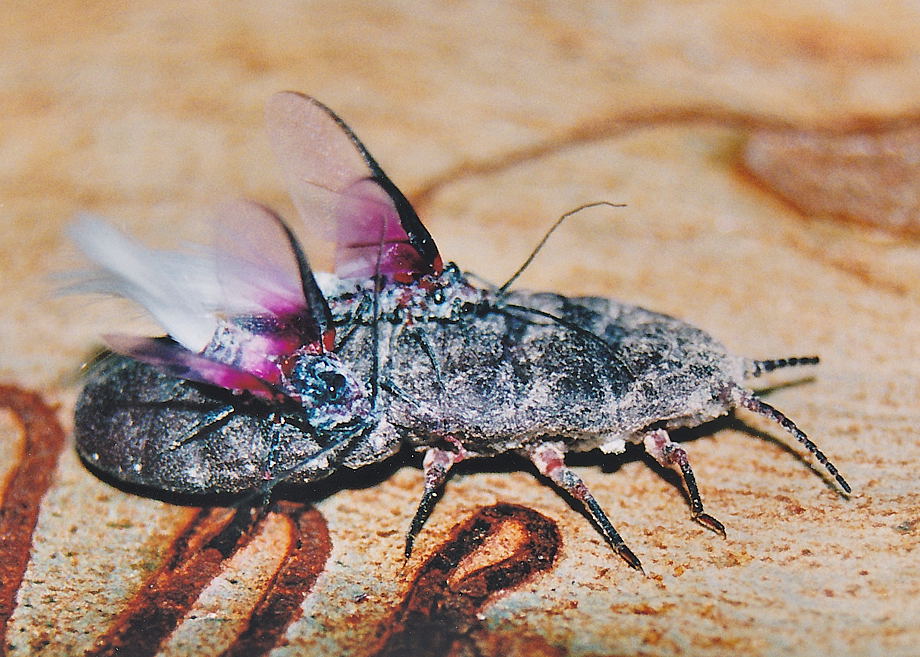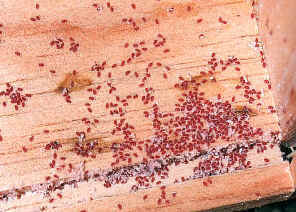|
| |
Family Margarodidae
- This page contains pictures and information about Bird of Paradise Flies -
Violet Phoenix that we
found in the Brisbane area, Queensland, Australia.
-
 - Body length winged male 10mm, wingless female 40mm
-
- As a member in the Mealy Bugs family, Bird of Paradise Fly is unbelievable
large. Females grow up
to 40mm, the largest in Soft Bug suborder. Bird of Paradise Fly is an incredible insect. It
Adult males have only one pair of wings. When we first it we thought it could be
a fly in order Diptera. After we saw
the female and we were
confused. We cannot tell even the order of this insect.
-
- By checking the reference information we
found that they are the Bird of Paradise Flies, belong to the Large Mealy Bugs
family Margarodidae. Their common name came from
the looks of the males - the purplish body and the long glassy white tail.
-
 
 -
- Last week (May 2003) we went for bush-walking in the conservation area near
Alexander Hill in Brisbane (where is a Eucalypt forest with sandy soil), we found some insects which were very
interesting. They were violet in colour. The males body length was 10mm with
bright white hair at the abdomen tip. When they were flying, they just look
like some cotton floating in the air. The males were flying around the gum trees. On the gum tree
trunk there were the large wingless females,
30-40mm body length,
also in violet colour. The females were either hiding under the bark or climbing
up on the tree trunk. There were males trying to mate with them.
-


 -
The male has a small head and two black eyes, antenna are about the same
length as it body. The male has only one pair of wings. We cannot see any sign of the
second pair of wings. The wing veins are simple. They do not put down their
wings when rest. We cannot see their mouth parts.
-
-
The female is much larger than the male and is wingless. She has the flat and
scout body with small eyes. She has the antenna about the
same length as the male's. She has three pairs of strong legs for climbing up the
gum tree trunk. We believe they are going to lay eggs on the tree top.
-
-
We brought some of them home to see if there are any further development. We
put them inside a wooden box with one glass windows. We found that the males
dead soon after mating. The females climbed to the root of the box.
Then on the wood surface they lay a white powder waxy substance of about the
area of 10mm X 40mm. Each female take 3 to 4 days to do that and dead soon
after. The
females' body reduced from 40mm to 10mm after laying those substance.
-
-
 
-
- About four weeks later, we found some small fellows came out from those white
substance. There were hundreds of them, less than 1mm in length, oval in shape.
They looked like tiny aphids. As their parents, they were violet in colour,
crawling slowly on the wood surface. We did not know how to feed them so we put
them back to the bush.
-
- From reference information the nymph develop underground attached to the
roots of host plants. Adults emerge from soil for mating and laying eggs
within a short period in autumn.
-
-
- After visiting this web page, Margaret Owen in Western Australia sent us
emails and photos, telling us that there is the similar interesting insect in
Western Australia. Details please visit the Silver Phoenix
page.
-
- Margaret shown us that the Silver Phoenix has eggs developed in female's
body. However, we found that the Violet Phoenix lays eggs and eggs develop
externally.
We think that actually it is not too difficult to relate the different 'incubation' process between the Violet Phoenix and the Silver Phoenix. Initially,
very long time ago,
all
species of Bird of Paradise flies lay eggs and young hatched like the
Violet Phoenix. Female found a suitable place, such as under bark, to lay
her eggs. Later some species evolved so that female did not have enough time to
lay their eggs but the eggs develop inside their body. It was an
advantage for those species since the female will die anyway, and this give the
eggs more protection.
-
- Reference:
- 1. Insects
of Australia - CSIRO, Division of Entomology, Melbourne University
Press, 2nd Edition 1991, p 459.
- 2. Species
Callipappus australis (Maskell, 1890) - Australian Biological Resources Study, Australian Faunal Directory.
- 3. Insects of Australia and New Zealand - R. J. Tillyard, Angus & Robertson, Ltd, Sydney, 1926,
p173, pl 6-10.
- 4. Giant females and bird-of-paradise flies: notes on the biology of Callipappus Guérin-Méneville (Hemiptera: Margarodidae) - Gullan, P.J.; Brookes, H.M. 1998, Australian journal of entomology, 37: 2-7.
-
- Back to Top
[ Up ] [ Bird of Paradise Flies - Violet Phoenix ] [ Bird of Paradise Flies - Silver Phoenix ] [ Cotton Cushion Scale ] [ Snow Ball Mealybug ]
| |
|









